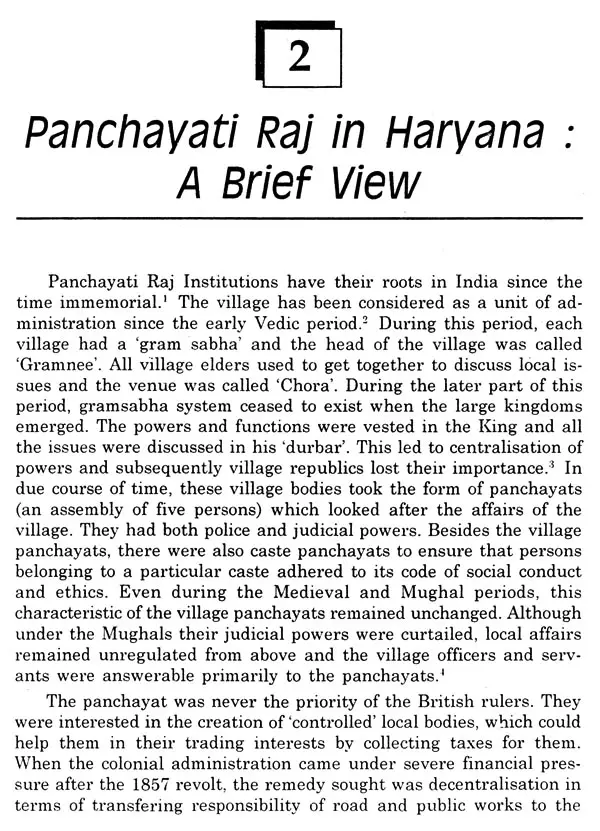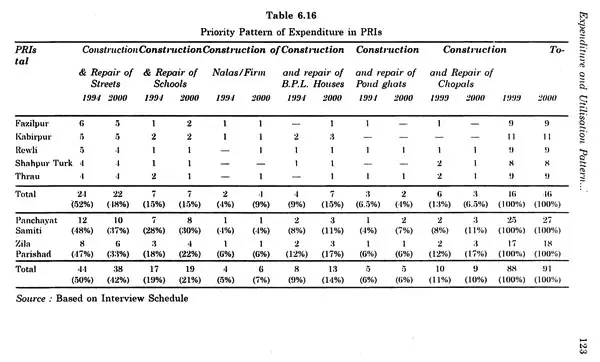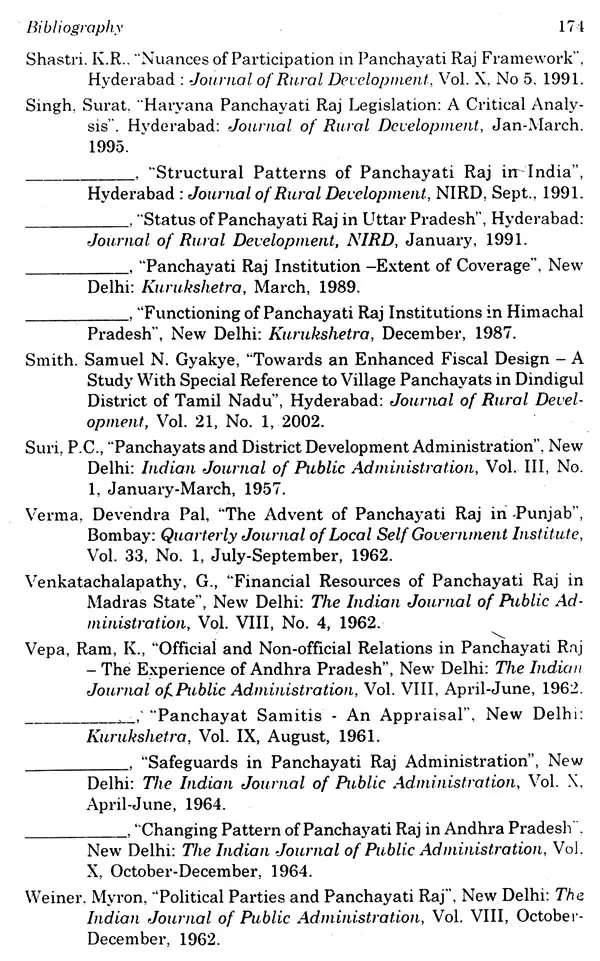
Resource Mobilisation and Utilisation
Book Specification
| Item Code: | UAH864 |
| Author: | Rajesh Kundu |
| Publisher: | Sanjay Prakashan |
| Language: | English |
| Edition: | 2005 |
| ISBN: | 8174531866 |
| Pages: | 176 |
| Cover: | HARDCOVER |
| Other Details | 9.00 X 6.00 inch |
| Weight | 340 gm |
Book Description
The advent of local bodies as self governing institutions has followed a number of theoretical as well as empirical studies but financial resources of panchayts need to be studied in the context of functions and duties devolved upon them. So this work is systematic attempt to study the mobilisation and utilisation of finances of panchayati raj institutions in Haryana. This being an empirical study would bridge a gap in the domain of panchayat finance studies in India in general and Haryana in particular. It has focused, mainly on the mobilisation of financial resources as well as their utilisation pattern.
Rajesh Kundu is presently working as a lecturer in the Department of Public Administration, M.D. University, Rohtak. He has also taught the under graduate classes for more than four years. He is a standing counseller of D.D.E. courses, M.D. University, Rohtak. He has contributed many research papers/articles to various inter-national seminars, national seminars and journals of repute.
Smooth functioning of government at all levels needs a sound financial system. In a democratic system, it is more imperative because the masses begin to regard this as a criterion for judging the success or failure of the system. Panchyat finances means of governing, raising and spending of money in these bodies. In view of variety of responsibilities of these institutions, it is necessary to enhance the finances of panchyati raj institutions. So, these vital issues are of crucial importance and they need to be addressed. The present study high lights the issues of mobilization and utilisation of finances of panchayati raj institutions in Haryana.
It is time to express gratitude towards those who have helped me in making this academic venture a success. I would like to express my gratitude to Dr. S.S. Chahar, Head, Department of Public Administration, M.D. University, Rohtak for his constant encouragement and for providng the required guidance and suggestions for carrying out the study. He indeed proved as a beckon light which ever kept my ship sailing smoothly.
My thanks are also due to all members of the Department, Dr. S.C. Arora, Dr. Shashi Mehra, Dr. S.S. Dahiya and Sh. Jagbir Singh Narwal for their constructive suggestions.
I am thankful to the B.D.P.O.. staff of Zila Parishad, D.R.D.A. DD.P.O. Office of Sonipat district, librarian of I.I.P.A., P.R.I.A.. New Delhi, H.I.P.A., Gurgaon, H.I.R.D., Nilokheri, Kurukshetra University, Kurukshtera and M.D. Univeristy, Rohtak for their help. and co-operation.
Moreover, In am thankful to the members and chairmen of Panchayati Raj Institutions who provided me the required information.
I am also thankful to all of my friends and relatives who have helped me in many ways.
This study would not have been possible without the emotional help of Suman, my wife and Shobhit, my son who provided my emotional succor.
Last but not least I owe by indebtedness to my parents who provided me an opportunity to undertake and complete this work.
The institution of panchayats is as old as the Indian civilization. The Constitution of independent India envisages organization of panchayati raj institutions and endows them with such powers and authority as may be necessary to enable them to function as units of self-government. The 73rd Amendment Act helped in the formation of laws with basic structural framework by which external interference could be curtailed and sufficient representation of weaker sections could be secured in panchayati raj institutions.
In a democratic system, evolution of sound financial system is imperative because the masses began to regard this as a criterion for judging the success of the system. Panchayati raj finances include the system of governing, raising and spending of money in these institutions. As a matter of fact the entire economy is constrained for resources. But. within an environment of overall scarcity, the sense of denial and deprivation is most pervasive and acute in the case of local bodies. The paucity of resources at the local level is all the more agonizing because it is at the grassroots of democracy that the dissatisfaction about the basic needs of the people are more keenly felt and articulated.
Local resource mobilization with local planning seems to be a promising vehicle for promoting rural development and alleviating poverty. It is also in conformity with the experience of some of the Scandinavian countries as well as Japan. They have been able to substitute the scarce resources with resource mobilisation at the local level in rural and agricultural sectors in particular. Such local resources cannot flow to higher levels but can improve productivity at the local level.
Finance is a sine-qua-non for any economic activity Financial management is the oxygen of local self government, at every level ² Till recently theoretical studies of local public economies and local finance have not received much attention of researchers. As an academic discipline, it has been hardly a fashionable subject till the rise of developmental economics. Economists have been concerned more with the national and international economics in a framework of immutable market mechanism and factor market specialization. Considerations of spatial dimension hardly take note of the local economy. The development of geo-economic theories of regional and sub regional economies, however, enable the students explore the local public economy more consistently. Local fiscal management has emerged as a major academic concern in the developing countries in the context of base line development.
Smooth functioning of government at all levels needs a sound. financial system. In a democratic system, it is more imperative because the masses begin to regard this as a criterion for judging the success or failure of the system. As pointed out by Jai Prakash Narain that. in the absence of sufficient resources panchayati raj institutions can. not run the administration properly. Panchayati raj finance means. the system of governing, raising and spending of money in these. institutions.
According to the Taxation Enquiry Commission, 1953-54 the crux of the problem of local bodies is finance The Santhanam Committee having studied the problem of panchayati raj finances observed, "although panchayati raj institutions have the formidable list of functions to discharge, they do not have the necessary financial resources to cope with these functions. Therefore, substantial and growing resources, it is essential for their stability and growth of these institutions Experience shows that self-government cannot function effectively unless local bodies have independent sources of income.
Financial management could be more effective if the development of appropriated funds had been left to the discretion of the spending agencies. The exercise of such judicious discretion, is conducive to a more effective and efficient discharge of responsibilities. It is recognised that the success of local bodies depends, to a considerable extent, on the financial resources available to them. There is also a need to maintain a balance between the expanding functions and the role entrusted to them and their financial resources Ashok Mehta Committee attributes the inability of panchayati raj institutions to come up to their expectations to their weak financial base.
The 73rd Constitutional Amendment Act has not only given the panchayati raj bodies constitutional protection but also defined them as Institutions of self-government"."But to evolve as institution of self-government, one of the fundamental requirements is to have adequate financial resources to enable them to discharge their responsibilities. In this regard, the Constitutional Amendment falls short of expectations as it has not created a clear cut financial provision for panchayati raj bodies as has been in the case of Centre State relations. The taxation powers of the Central and State governments are listed in Union List and State List respectively. As there is no mention of the local list for local bodies, they can have only those powers, which the State government devolves on them from their own taxation powers listed in items 45 to 66 of the State List. Article 243 (H), which refers to empowerment of Panchayats by the State to levy taxes, duties, tolls, etc., is only an enabling provision. The actual devolution rests upon the State government and the net result is that taxes are assigned to local bodies and they do not have independent powers of taxation. The only consolation is constitution of State Finance Commission after every five years. But, again, the role of the State Finance Commission is limited as it cannot create resources but can only make recommendations regarding sharing of resources between various levels. Implementing the recommendations is left on the State governments and they may or may not agree to all it recommendations. Financial resources of panchayats need to be studied in the context of functions and duties devolved upon them.
**Contents and Sample Pages**















